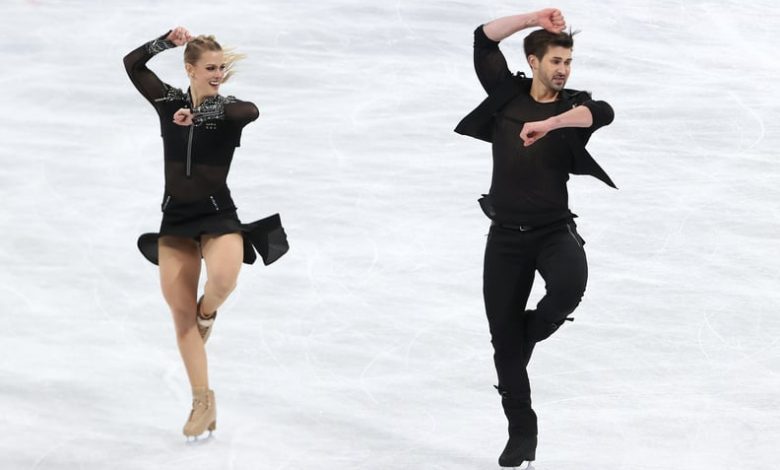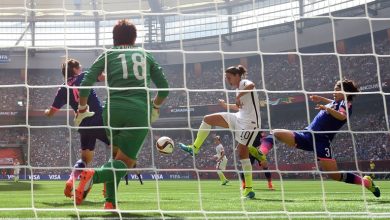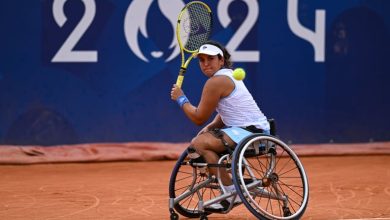15 Figure Skating Jumps, Spins, and Other Moves, Explained

Figure skating is right up there with gymnastics in terms of its ability to make your jaw drop with athletes’ physics-defying moves. But between the sport’s complicated scoring system, the vast number of skills the skaters perform, and the onslaught of sequins, it’s OK if watching figure skating makes you feel as overwhelmed as you are fascinated. To make the performances a little easier to understand, here are some basic figure skating moves you should know.
Although the different figure skating disciplines have their own distinct features, understanding even a handful of figure skating moves will help you track what’s happening across the board. Figure skating is a fast-moving sport, and it can sometimes be difficult to identify every element in real time — especially jumps, which can only be distinguished by looking closely at a skater’s feet. During the live broadcasts, there will always be a scoring box on screen that labels the moves (plus their levels and grades of execution), but if you want to learn more about the most common figure skating moves, this guide is a good place to start.
First, let’s get one important thing out of the way. You’re going to hear a lot of talk about “edges,” both here and on TV, and having a basic understanding of edges is key to deciphering jumps and step sequences. So what is an edge, exactly? A figure skating blade is made from a thin piece of metal, which has a very narrow “flat” surface and two sharp edges — just imagine a knife with a super thick blade. Figure skaters move by skating on the edges, or the actual sharp parts of the blade.
When it comes to jumping, edges are of the essence. An “inside edge” refers to the blade edges that lean “in” towards the other foot, whereas an “outside edge” is the edge of the blade on the “outside” of each foot, or away from the body. Figure skating jumps are identified by the edge the skater takes off from, and whether or not they use a toe-pick assist (aka, the small ridges at the front of the skate) for takeoff. With that, you’re ready to dive into more figure skating terms.
A toe loop — the third jump in the video above — is generally considered the easiest jump to execute in figure skating. The skater enters the jump on a back outside edge, uses their opposite foot’s toe pick to assist on the takeoff, and then lands on the same back outside edge after rotating in the air. Because it’s the simplest jump, it’s also the most common one to add as the second jump in a combination, as Nathan Chen did here.
A flip has a similar takeoff as a toe loop, but it’s a bit more complicated. Although the skater still uses the toe pick of their free leg to assist on the takeoff, they must take off from a back inside edge, which is considerably less stable and more difficult. The jump then lands on the back outside edge of the opposite foot.
Named after Alois Lutz, the Austrian skater who invented it in 1913, the lutz jump is one of the most difficult jumps in figure skating. It starts with a takeoff from a back outside edge, uses a toe pick to assist the takeoff, and lands on the opposite foot’s back outside edge. It can be performed in multiple rotations including a quad lutz, shown here. Edge mistakes on the lutz entry are so common that they have their own nickname: a “flutz.”
The salchow is typically considered the easiest of the edge jumps, or jumps that do not use a toe pick to assist on takeoff. It requires a takeoff from the back inside edge of one foot, then a landing on the back outside edge of the opposite foot.
A loop jump is also an edge jump, with no toe-pick assist on takeoff. It takes off from the back outside edge of one foot, then lands on that same back outside edge.
The axel is both the easiest figure skating jump to identify and the hardest one to execute. It’s easy to see, even for untrained eyes, because it’s the only jump that takes off from a forward edge rather than a back one. That forward outside-edge takeoff, however, means that there’s an extra half-rotation in the air before the jump is landed on the back outside edge of the opposite foot. (This means a triple axel, for example, is three and a half rotations.)
Throws are an element exclusive to pairs skating. A throw, more accurately called a “throw jump,” is a partnered jump in which one partner assists the other on takeoff. This is usually done by one partner “throwing” the other by the waist as the jumping partner takes off. The result is larger and higher jumps than a skater could achieve individually, although the number of rotations remains the same.
Another element only seen in pairs skating, a twist involves one partner throwing the other into the air above their head. The thrown partner’s body should be parallel to the surface of the ice (rather than perpendicular, as in a normal jump), and they rotate, or “twist,” a number of times before being caught and set down.
While you might see a twizzle in any discipline as part of a step sequence, they’re a formal, required element only in ice dance. Twizzles are a series of rapid, traveling turns or spins in which the skaters move across the ice while rotating on one leg. A set of synchronized twizzles, usually involving changes of foot, direction, and arm or leg position, are required in all ice-dance programs.
Lifts are a key component for both pairs and ice dance, but the rules for them are different between disciplines. In general, both require one partner to lift the other off the ice, while the lifting partner rotates or skates in a line and the lifted partner executes complicated positions. In pairs skating, lifts involve the lifting partner extending their arms fully overhead, while in ice dance, fully extending the arms for more than a brief moment is prohibited.
Pairs lifts are categorized by the manner in which the lifting partner holds their partner’s body in the air, as well as the position of the lifted partner relative to the ice and to their partner. For instance, a “press” lift resembles one partner “pressing” or “pushing” their partner into the air and the two rotating together, while a “lasso” lift involves the lifted partner rotating “around” the lifter.
Ice-dance lifts are usually more acrobatic, and they’re categorized by the motion of the lifting partner. A stationary lift, for example, involves the lifting partner rotating in place during the element, while a curve lift (shown here) requires the lifting partner to skate in one direction along a curved path.
Step sequences are usually fairly easy to identify, and they’re often the most fun part of a program to watch. Essentially, a step sequence involves the skater(s) moving across the ice while executing a series of complicated turns and changes of foot. There are no jumps or lengthy spins, just fancy footwork that’s a lot harder than it looks! Skaters are judged based on the quality of their edges, the precision of their movements, their creativity, and their musicality.
Spins in figure skating tend to involve several different positions. You’ll see many of these both on their own or in sequence or “combination.” A camel spin involves the skater extending one leg behind them at a 90-degree angle while they spin on the other foot. Skaters’ bodies will look a little like an upside-down “L” shape during the camel spin.
Sit spins have one major identifying factor: the spinning leg is bent at the knee into a crouch. The free leg may be held in any other position: to the front, back, or side.
All spins in this group involve spinning on one leg while the other leg is elevated and extended in any position that’s not a 90-degree angle. Layback spins, in which a skater holds one leg at an angle behind them while arching their upper body to look upwards, are one of the most popular types of upright spins. Some skaters do a “catch foot” variation, where they grab the blade of their free leg during the spin.
Other popular upright spins require even more flexibility. An “I” spin requires the skater to lift their free leg all the way up at 180 degrees so that their body appears to form a capital “I” shape. You also might see a Biellmann spin, in which the skater grabs their free leg, holds it behind and above their head, and arches their upper body, as shown here.
A flying spin is sort of a combination of a jump and spin. What sets it apart is the entrance into the spin, which happens when the skater launches, or “flies,” into a small jump, lands on their spinning leg, and begins to rotate. Typically, this leads into a sit or camel spin (as seen here).
Amanda Prahl is a freelance writer, playwright/lyricist, dramaturg, teacher, and copywriter/editor. Amanda has also contributed to Slate, Bustle, Mic, The Mary Sue, and others.




